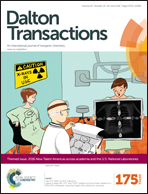Synthesis and characterization of potassium aryl- and alkyl-substituted silylchalcogenolate ligands†
Abstract
Treatment of either triphenyl(chloro)silane or tert-butyldiphenyl(chloro)silane with potassium metal in THF, followed by addition of 18-crown-6, affords [K(18-crown-6)][SiPh3] (1) and [K(18-crown-6)][SiPh2tBu] (2), respectively, as the reaction products in high yield. Compounds 1 and 2 were fully characterized including by multi-nuclear NMR, UV/vis and IR spectroscopies. Addition of elemental chalcogen to either 1 or 2, results in facile chalcogen insertion into the potassium–silicon bond to afford the silylchalcogenolates, [K(18-crown-6)][E–SiPh2R] (E = S, R = Ph (3); E = Se, R = Ph (4); E = Te, R = Ph (5); E = S, R = tBu (6); E = Se, R = tBu (7); E = Te, R = tBu (8)), in moderate to good yield. The silylchalcogenolates reported herein were characterized by multi-nuclear NMR, UV/vis and IR spectroscopies, and their solid-state molecular structures were determined by single-crystal X-ray crystallography. Importantly, the reported compounds crystallize as discrete monomers in the solid-state, a structural feature not previously observed in silylchalcogenolates, providing well-defined access routes into systematic metal complexation studies.

- This article is part of the themed collection: New Talent: Americas

 Please wait while we load your content...
Please wait while we load your content...